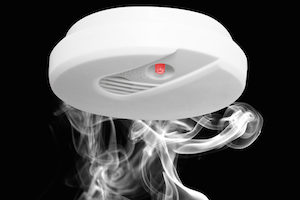 The desire to protect your loved ones from danger is a basic instinct, but providing this protection can be complicated. One of the most primal dangers from which we seek protection is fire. The Centers for Disease Control and Prevention state that, on average in the United States in 2010, someone died in a fire every 169 minutes, and someone was injured every 30 minutes. The CDC also says about 85% of all U.S. fire deaths occur in homes. This is why it is vital to have smoke alarms in your home.
The desire to protect your loved ones from danger is a basic instinct, but providing this protection can be complicated. One of the most primal dangers from which we seek protection is fire. The Centers for Disease Control and Prevention state that, on average in the United States in 2010, someone died in a fire every 169 minutes, and someone was injured every 30 minutes. The CDC also says about 85% of all U.S. fire deaths occur in homes. This is why it is vital to have smoke alarms in your home.
In the mid-1960s, battery powered smoke alarms were first introduced in the United States. FEMA has stated that by 1991, 81% of all American homes had at least one smoke detector. According to the National Fire Protection Association, approximately 96% of all homes now have smoke detectors. The CDC says that in 2010, fire departments responded to 384,000 home fires in the U.S., which claimed the lives of 2,640 people and injured another 13,350; fire and burn injuries cost approximately $7.5 billion per year.
Why are so many people losing their lives in home fires? The smoke alarms in most homes are defective.
Types of Smoke Alarms
There are three major types of smoke alarms:
- Ionization detectors, which have a chamber with two plates which produce electric currents. When smoke enters the chamber, the current is disrupted, setting off the alarm. An ionization detector can quickly sense fast-moving fires, but has huge shortcomings in detecting smoldering, slow moving fires; such fires can go completely undetected by an ionization alarm.
- Photoelectric detectors, which work by using a beam of light and a light receptor or photocell. When smoke appears between the light and the receptor, the receptor signals the photocell sensor to set off the alarm. The photoelectric smoke alarm is better for smoky, slower-burning fires.
- There are also smoke alarms which combine ionization and photoelectric capabilities in one unit. These are known as dual sensor smoke alarms.
Problems with Ionization Alarms
Ionization detectors are the most common type on the market, making up about 90% of all smoke detectors installed in homes today. However, the majority of home fires start at night while we sleep and are low heat, smoldering fires which result in the ionization detector’s being worthless. Testing has shown a fire can smolder and produce deadly amounts of smoke for more than half an hour, with an ionization detector never sounding.
There is no way to predict what type of fire you could have in your home. Therefore, you need both technologies installed for the maximum amount of protection.
What to Do if You are the Victim of a House Fire
If you or a loved one has been the victim of a death or substantial injury from a fire, you may have a defective smoke alarm case. If you or a family member has been the victim of a house fire, it is important that you understand what options you have for compensation. The lawyers of Wolff Ardis, P.C. can help you determine what steps you should take to protect your rights, including pursuing a case against a product manufacturer, the company that sold the alarm, or others. There are certain legal requirements that must be met to prove your claim and receive compensation. The lawyers of Wolff Ardis, P.C. can help you gather the evidence you need in order to recover what you deserve.







